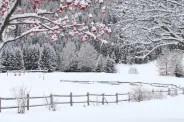
Winter is Still Coming! Prepare Your Landscape
Implement some of these strategies to keep your landscape plants protected from the cold!
Read More...Unfortunately, your neighbors will not be the only ones admiring your lawn. Literally an army of various insect types and diseases will seek to feed on your lawn that we have worked so hard to maintain and get in shape.
While turf grass has its own natural defenses against such environmental dangers, occasionally it needs a little bit of help. Our technicians are specially trained to identify all types of turf grass insect and disease issues and recommend appropriate treatment options.
Grubs are the most common turf insect pests. However, turf caterpillars, such as cutworms, armyworms, and webworms, are also looking to make a meal out of your lawn. Chinch bugs and billbugs are seen occasionally as well.
Although they do not eat the turf, fire ants can cause an unattractive appearance in the grass and attack small children and pets (as well as adults) if their nest is disturbed. We have treatment options for these pests.
Turf also can be susceptible to disease. As a general rule, turf diseases afflict the turf when it is in a weakened state due to adverse environmental conditions.
For fescue, this is usually due to hot weather in the summer. During this time, brown patch is common. Treatments for this turf disease can improve the appearance of the grass, but it must usually be retreated at 2-4 week intervals throughout the summer to maintain the effect. Fescue can also be attacked by other diseases, including pythium blight, which affects newly seeded turf grass.
Bermuda and zoysia can be affected by diseases, usually in the spring and fall. Both like to go very quickly from winter to summer and then back again from summer to winter. Extended periods of warm days and cool nights in the spring and fall create the perfect conditions for disease development in bermuda and zoysia.
Dollar spot is common in both, as is brown patch, especially in zoysia, where it is often referred to as zoysia patch or large patch. Treatments for these will help the appearance of the grass until the hot or cold weather comes and they become less susceptible to disease attack.
Bermuda and zoysia can also be affected by other turf diseases, such as spring dead spot, rusts, leaf spots, and others for which treatment options are available.
Whatever the turfgrass problem, our technicians are trained to identify and recommend solutions for any issues that arise.